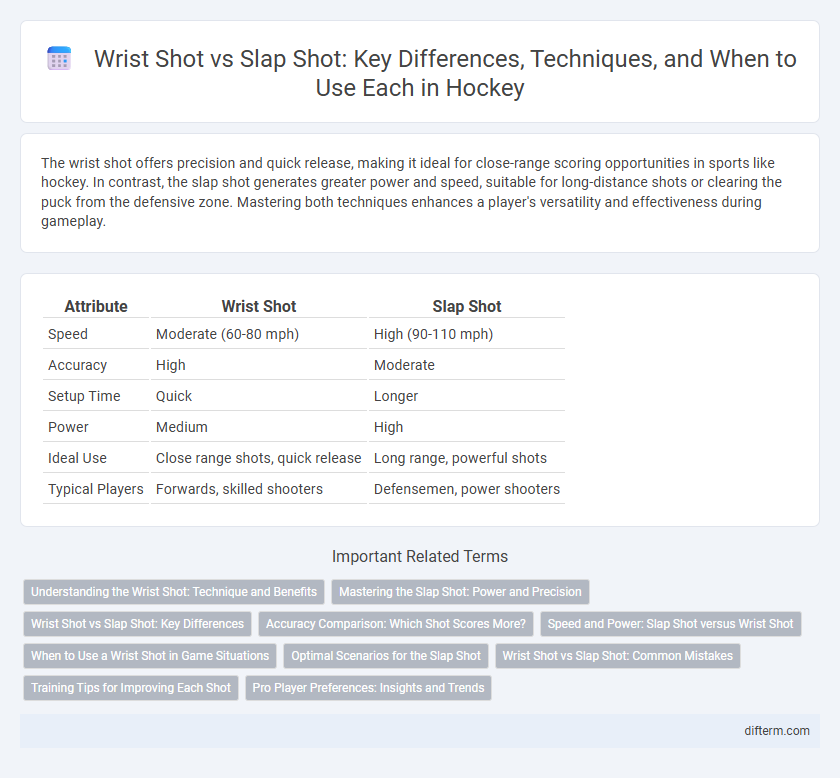The wrist shot offers precision and quick release, making it ideal for close-range scoring opportunities in sports like hockey. In contrast, the slap shot generates greater power and speed, suitable for long-distance shots or clearing the puck from the defensive zone. Mastering both techniques enhances a player's versatility and effectiveness during gameplay.
Table of Comparison
| Attribute | Wrist Shot | Slap Shot |
|---|---|---|
| Speed | Moderate (60-80 mph) | High (90-110 mph) |
| Accuracy | High | Moderate |
| Setup Time | Quick | Longer |
| Power | Medium | High |
| Ideal Use | Close range shots, quick release | Long range, powerful shots |
| Typical Players | Forwards, skilled shooters | Defensemen, power shooters |
Understanding the Wrist Shot: Technique and Benefits
The wrist shot in hockey is executed by quickly snapping the wrist to propel the puck with precision and speed, allowing for better accuracy compared to other shot types. This technique involves a controlled release, making it ideal for scoring in close-range situations and during quick, unexpected plays. Its benefits include enhanced shot control, faster puck release, and increased accuracy, making it a crucial skill for forwards aiming to outmaneuver goaltenders.
Mastering the Slap Shot: Power and Precision
Mastering the slap shot requires a combination of explosive power and precise timing to generate maximum puck velocity. Proper weight transfer, stick flex, and follow-through mechanics are crucial for unleashing a powerful and accurate shot that can beat goaltenders. Unlike the wrist shot, which prioritizes quick release and accuracy, the slap shot emphasizes sheer force, making it ideal for long-range scoring opportunities in hockey.
Wrist Shot vs Slap Shot: Key Differences
Wrist shots offer precision and quick release, making them ideal for close-range scoring opportunities, while slap shots generate maximum power and speed, suitable for long-distance attempts and clearing the puck. The wrist shot relies on controlled flicking motion from the wrists, allowing for better accuracy and rapid puck elevation. In contrast, the slap shot involves a full wind-up and powerful swing, sacrificing some accuracy for increased velocity and force.
Accuracy Comparison: Which Shot Scores More?
Wrist shots offer superior accuracy compared to slap shots due to their controlled release and precise puck handling, making them more effective for scoring in close-range situations. Slap shots generate higher velocity but sacrifice accuracy, often resulting in fewer goals despite greater power. Players aiming for consistent scoring success typically rely on wrist shots for targeted placement and better goal conversion rates.
Speed and Power: Slap Shot versus Wrist Shot
Slap shots deliver greater speed and power due to the full backswing and follow-through, often exceeding 90 mph in professional hockey. Wrist shots, while generally slower at around 70-80 mph, provide superior accuracy and quicker release times. Choosing between them depends on whether raw velocity or precision is prioritized in game situations.
When to Use a Wrist Shot in Game Situations
A wrist shot is ideal in game situations requiring precision and quick release, such as when shooting from close to the net or in tight spaces where accuracy is crucial. It allows players to swiftly catch goalies off-guard due to its speed and accuracy over short distances. Use a wrist shot when you need to quickly put the puck on net without telegraphing your intent, especially during fast breaks or in crowded offensive zones.
Optimal Scenarios for the Slap Shot
Slap shots are optimal in scenarios requiring maximum power and distance, such as clearing the puck from the defensive zone or taking long-range shots on goal during power plays. Players typically use slap shots when they have sufficient time to wind up and need to generate a high-velocity shot that can surprise the goalie. This technique is most effective in open ice situations where accuracy can be slightly sacrificed for sheer force and puck speed.
Wrist Shot vs Slap Shot: Common Mistakes
Wrist shots often suffer from poor puck control and lack of follow-through, reducing accuracy and speed. Conversely, slap shots frequently involve improper weight transfer and insufficient coil, leading to decreased power and slower release time. Mastering proper technique for each shot enhances precision, velocity, and overall scoring effectiveness in hockey.
Training Tips for Improving Each Shot
Mastering the wrist shot requires focused drills on quick puck release and precise hand positioning to enhance accuracy and speed. For developing a powerful slap shot, concentrate on weight transfer techniques and strong follow-through motions to maximize shot velocity. Incorporating resistance training and repetitive shooting practice increases muscle memory and overall shot effectiveness in both techniques.
Pro Player Preferences: Insights and Trends
Pro hockey players often prefer wrist shots for their accuracy and quick release during critical game moments, while slap shots are favored for their power and long-range scoring potential. Statistical analyses reveal that forwards typically rely more on wrist shots to capitalize on precision, whereas defensemen leverage slap shots for effective shooting from the blue line. Recent trends highlight an increasing emphasis on wrist shot techniques in training programs focused on enhancing shot speed and accuracy among elite professional athletes.
wrist shot vs slap shot Infographic

 difterm.com
difterm.com